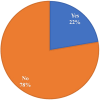Evaluating the Correlation Between Prosthodontic Interventions and Chest Infections: A Comprehensive Research Analysis
- PMID: 39233992
- PMCID: PMC11374137
- DOI: 10.7759/cureus.66208
Evaluating the Correlation Between Prosthodontic Interventions and Chest Infections: A Comprehensive Research Analysis
Abstract
Background: There is growing interest in the relationship between prosthodontic therapies and outcomes related to systemic health, particularly respiratory infections. Respiratory infections are a leading cause of global morbidity and mortality, particularly among vulnerable populations such as immunocompromised individuals. The World Health Organization reports that lower respiratory infections are among the top causes of death worldwide, underscoring the importance of understanding their potential link to prosthodontic procedures. Dental operations, such as prosthodontic therapies, may alter the mouth flora and thus affect respiratory health.
Objective: This research aimed to investigate the relationship between prosthodontic procedures and chest infections.
Methodology: This research was an observational prospective cohort study conducted from January 2023 to December 2023 at the Pakistan Institute of Medical Sciences (PIMS) located in Islamabad, Pakistan. One hundred thirty individuals in the cohort, who were at least 18 years old, had a range of prosthodontic procedures, such as total edentulous solutions and tooth restoration. Electronic health data were used for participant selection to minimize selection bias and guarantee diverse representation. Comprehensive evaluations of cardiovascular health, immunological state, pulmonary function, and medical histories were all part of the data-gathering process. Structured questionnaires and interviews were also used to get patient feedback. Using SPSS Statistics software (version 27; IBM Corp., Armonk, NY), statistical analysis was performed to examine the relationships between prosthodontic treatments and chest infections using descriptive statistics and logistic regression.
Results: PIMS hosted 130 participants in this research, which found that 29 patients, or 22% of the total, had chest infections after surgery. Chest infection rates were 15.15% (five out of 33) in the 18-39 age group, 21.21% (14 out of 66) in the 40-59 age group, and 32.26% (10 out of 31) in the 60+ age group, according to age-specific analysis. Complete edentulous solutions (38 cases, 29.23%) and tooth restoration (55 cases, 42.31%) were the most frequently performed procedures. Compared to tooth restoration (n=15; 55.17%), complete edentulous solutions (n=8; 27.59%) had increased infection risks, according to logistic regression. Following prosthodontic procedures, respiratory health measures improved: respiratory rate dropped to 17.8/min, oxygen saturation rose to 98.1%, and frequency of coughing fell to 1.9/day.
Conclusion: This research highlights the need for careful post-operative respiratory surveillance by elucidating the strong associations between prosthodontic procedures and chest infections.
Keywords: chest infections; dental patient-reported outcomes; oral health; prosthodontic interventions; tooth restoration.
Copyright © 2024, Muqeet et al.
Conflict of interest statement
Human subjects: Consent was obtained or waived by all participants in this study. Institutional Review Board of Dental College, Heavy Industries Taxila Education City Institute of Medical Sciences (HITEC-IMS), Taxilla, Pakistan issued approval HITEC-IMS-IRB-03. Animal subjects: All authors have confirmed that this study did not involve animal subjects or tissue. Conflicts of interest: In compliance with the ICMJE uniform disclosure form, all authors declare the following: Payment/services info: All authors have declared that no financial support was received from any organization for the submitted work. Financial relationships: All authors have declared that they have no financial relationships at present or within the previous three years with any organizations that might have an interest in the submitted work. Other relationships: All authors have declared that there are no other relationships or activities that could appear to have influenced the submitted work.
Figures
Similar articles
-
[Standard technical specifications for methacholine chloride (Methacholine) bronchial challenge test (2023)].Zhonghua Jie He He Hu Xi Za Zhi. 2024 Feb 12;47(2):101-119. doi: 10.3760/cma.j.cn112147-20231019-00247. Zhonghua Jie He He Hu Xi Za Zhi. 2024. PMID: 38309959 Chinese.
-
The Diagnosis and Initial Management of Children Presenting With Premature Loss of Primary Teeth Associated With a Systemic Condition.Cureus. 2024 Jun 14;16(6):e62402. doi: 10.7759/cureus.62402. eCollection 2024 Jun. Cureus. 2024. PMID: 39006675 Free PMC article.
-
Prosthodontic status and recommended care of patients with epilepsy.J Prosthet Dent. 2005 Feb;93(2):177-82. doi: 10.1016/j.prosdent.2004.11.008. J Prosthet Dent. 2005. PMID: 15674230
-
Interventions for replacing missing teeth: alveolar ridge preservation techniques for dental implant site development.Cochrane Database Syst Rev. 2021 Apr 26;4(4):CD010176. doi: 10.1002/14651858.CD010176.pub3. Cochrane Database Syst Rev. 2021. PMID: 33899930 Free PMC article.
-
Need for occlusal therapy and prosthodontic treatment in the management of temporomandibular disorders. Part II: Tooth loss and prosthodontic treatment.J Oral Rehabil. 2000 Aug;27(8):647-59. doi: 10.1046/j.1365-2842.2000.00623.x. J Oral Rehabil. 2000. PMID: 10931259 Review.
References
-
- The oral microbiome - an update for oral healthcare professionals. Kilian M, Chapple IL, Hannig M, et al. Br Dent J. 2016;221:657–666. - PubMed
-
- Treatment planning considerations in the older adult with periodontal disease. Curtis DA, Lin GH, Rajendran Y, Gessese T, Suryadevara J, Kapila YL. Periodontol 2000. 2021;87:157–165. - PubMed
LinkOut - more resources
Full Text Sources




